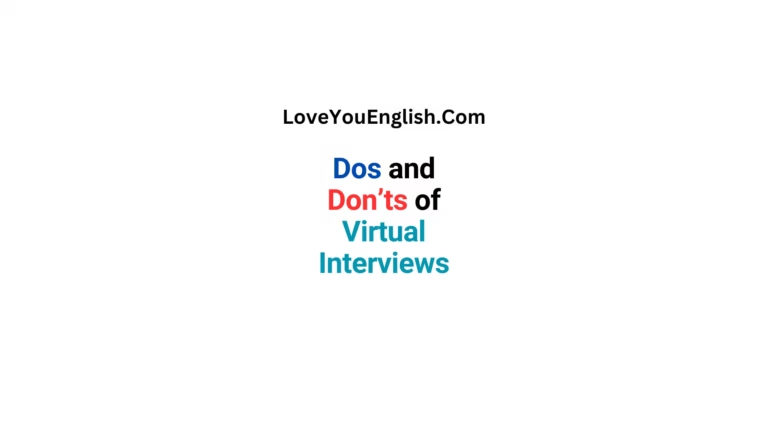Interviewing for a Leadership Role? Here’s How to Stand Out
Interviewing for a Leadership Role? Here’s How to Stand Out
When you are applying for a leadership role, the interview is an important moment to prove your skills, experience, and potential. It’s your chance to show that you can manage teams, make strategic decisions, and take responsibility.
However, interviews for leadership roles can be challenging, as they require more than just the usual questions and answers. You need to demonstrate your ability to inspire, lead, and solve problems. So, how can you stand out in such a competitive interview process?
In this post, I’ll share key strategies to help you excel when interviewing for a leadership position.
1. Understand the Role and Company
Before stepping into the interview, it is essential to fully understand the role you’re applying for and the company you want to work for. Research is critical.
Here’s how you can do it:
- Company Research: Look into the company’s values, culture, and current challenges. This will help you understand how your leadership style aligns with their needs. For instance, if the company emphasizes innovation, you can highlight how you’ve led teams to develop new products or services.
- Role Understanding: Know the specific responsibilities and expectations for the leadership position. You should be clear on the scope of your role and how you’ll contribute to the company’s goals. This knowledge helps you talk about your experience in ways that directly relate to the role.
Tip: Prepare a few questions about the company’s future goals or the challenges they face. Asking smart questions shows that you’re serious and have done your homework.
2. Showcase Leadership Experience
When you’re applying for a leadership position, it’s important to demonstrate your leadership experience and how you’ve made an impact in previous roles. This doesn’t just mean having “leadership” in your job title. You should focus on times when you’ve led projects, motivated teams, or helped your company achieve its objectives.
Use the STAR Method (Situation, Task, Action, Result) to structure your answers. Here’s how to do it:
- Situation: Describe a leadership challenge you faced. For example, leading a team through a period of change or managing a project with tight deadlines.
- Task: Explain the goal or the problem you needed to solve. Were you tasked with improving performance, increasing team engagement, or launching a new product?
- Action: Describe the steps you took as a leader to address the situation. This is where you can highlight your decision-making, communication, and problem-solving skills.
- Result: Share the outcome of your actions. Did you exceed expectations? Were you able to deliver the project on time or improve the team’s performance? Make sure to provide concrete metrics whenever possible.
By providing detailed examples, you can show how your leadership skills directly contributed to success.
3. Highlight Your Leadership Style
Leadership isn’t just about telling people what to do—it’s about motivating, inspiring, and guiding your team toward success. Employers want to know what kind of leader you are and how your style can benefit the organization.
Take time to reflect on your leadership style before the interview. Are you more of a collaborative leader, valuing teamwork and input from others? Or do you prefer to take charge and make decisions independently? It’s important to be honest about your style and explain why it works for you and your teams.
- “I believe in a transformational leadership style, where I focus on inspiring and motivating my team to reach their full potential. I encourage open communication and regularly check in to ensure everyone is aligned with our goals.”
- “I lead by example, ensuring that I am always available for my team and leading from the front. I believe in holding myself accountable and setting clear expectations.”
Additionally, be ready to adapt your leadership style to different situations. Great leaders are flexible, understanding that one approach may not work for all situations or individuals.
Tip: If you know the company values certain leadership qualities (e.g., innovation, communication, or resilience), make sure you emphasize these traits in your response.
4. Demonstrate Problem-Solving Skills
One of the main responsibilities of a leader is to solve problems—whether it’s resolving conflicts within the team, handling difficult situations with clients, or dealing with organizational challenges. During the interview, expect to be asked how you’ve handled problems in the past.
It’s important to show that you can think critically and make informed decisions quickly. Here are some ways to demonstrate problem-solving skills:
- Talk about a difficult situation: Choose an example where you were able to solve a major problem. This could be a crisis, a conflict, or a major decision you had to make. Explain your thought process, what steps you took, and how you managed the situation.
- Focus on results: Always explain the positive outcomes of your actions. Did your solution improve team performance, reduce costs, or increase customer satisfaction?
Tip: Emphasize your ability to analyze situations from different perspectives, involve relevant stakeholders, and find solutions that align with the company’s values.
5. Highlight Communication Skills
Communication is a crucial skill for any leader. Whether it’s communicating with your team, other departments, or clients, being able to express ideas clearly and persuasively is essential. During your interview, you need to demonstrate that you are a strong communicator.
Here’s how to show this:
- Explain how you keep your team informed: You can talk about how you ensure your team understands goals, timelines, and expectations through regular updates or meetings.
- Describe your approach to listening: A good leader listens as much as they talk. You can mention how you encourage feedback from your team and how you use that feedback to make better decisions.
- Give examples of conflict resolution: Conflict is inevitable in any team. Talk about how you’ve used communication to resolve misunderstandings or disagreements among team members.
Tip: Mention any public speaking or presentation experience you have. If you’ve led meetings, conferences, or workshops, that shows your ability to communicate with large groups.
6. Demonstrate Emotional Intelligence (EI)
Emotional intelligence is a key leadership trait. It’s the ability to understand and manage your emotions, as well as the emotions of others. Leaders with high EI can build strong relationships, reduce workplace stress, and create a positive work environment.
To show emotional intelligence during your interview, you can focus on:
- Self-awareness: Talk about how you stay aware of your emotions and how they influence your decisions.
- Empathy: Explain how you understand and consider the feelings and perspectives of your team members when making decisions.
- Self-regulation: Share examples of how you manage stress, remain calm under pressure, and stay positive in difficult situations.
Tip: You can discuss how you have helped a team member through a challenging time or how you’ve fostered an inclusive environment where all team members feel valued.
7. Discuss Your Vision for the Future
Employers want to know that you have a vision for the future and a clear strategy for achieving the company’s goals. Leaders must inspire others by setting direction and helping their teams understand how they can contribute to long-term success.
You might be asked questions like, “Where do you see the company in the next five years?” or “How would you lead your team to achieve future goals?” This is your chance to show that you’re forward-thinking and have ideas for how to grow and improve.
When answering, be sure to:
- Show that you’re thinking strategically.
- Explain how your leadership will help the company achieve its vision.
- Tie your personal goals to the organization’s mission.
Tip: Be specific about what you want to achieve. Instead of saying, “I will help the company grow,” say something like, “I plan to focus on expanding the company’s market share by focusing on customer satisfaction and developing new partnerships.”
8. Emphasize Adaptability
Leadership roles require flexibility. Things don’t always go as planned, and sometimes leaders must adjust their approach. During your interview, be prepared to demonstrate how adaptable you are in different situations.
This could involve:
- Managing sudden changes in priorities or resources.
- Leading your team through change, such as restructuring or adopting new technology.
- Showing that you can thrive in uncertain or challenging conditions.
Tip: Give examples of how you’ve successfully adapted in the past, such as leading through change or responding to unexpected challenges.
Conclusion
Interviewing for a leadership role can be a nerve-wracking experience, but with the right preparation, you can stand out and make a lasting impression. Remember to understand the role and company, showcase your leadership experience, and highlight your communication and problem-solving skills. Show that you have emotional intelligence and a vision for the future, and be ready to adapt to different situations. By following these tips and presenting yourself confidently, you’ll increase your chances of landing that leadership role.
Good luck!
Read more:
- Self-Introduction Conversations in Business English
- The Role of Career and Technical Education
- Professional Development for Educators
- Professional Growth: A Path to Success
- Professional Growth for Teachers








